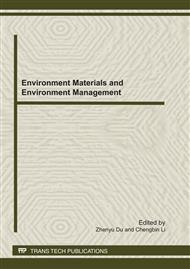[1]
Environmental Monitoring of China. Chinese Soil Elements Background. Beijing: China Environmental Science Press(1990).
Google Scholar
[2]
G. C. Fang, C. N. Chang, Y. S. Wu, P. P. C. Fu, K. F. Chang and D. G. Yang. Ambient suspended particulate matters and related chemical species study in central Taiwan, Taichung during 1998-2001. Atmospheric Environment 36, 1921-1928(2002).
DOI: 10.1016/s1352-2310(02)00187-5
Google Scholar
[3]
X. H. Wang, X. H. Bi, G. Y. Sheng, J. Fu. Chemical composition and source of PM10 and PM2. 5 aerosols in Guangzhou, China. Environmental Monitoring and Assessment119, 1/3: 425 – 439(2006).
DOI: 10.1007/s10661-005-9034-3
Google Scholar
[4]
K. F. Ho, S. C. Lee, J. C. Chow,J. G. Watson. Characterization of PM10 and PM2. 5 source profiles for fugitive dust in Hong Kong. Atmospheric Environment 37, 8: 1023-1032(2003).
DOI: 10.1016/s1352-2310(02)01028-2
Google Scholar
[5]
Y. Gao, E. D. Nelson, M. Field, P. Q. Ding, H. Li, R. M. Sherrell, C. L. Gigliotti, D. A. Van Ry, T. R. Glenn and S. J. Eisenreich. Characterization of atmospheric trace elements on PM2. 5 particulate matter over the New York-New Jersey harbor estuary. Atmospheric Environment 36, 1077-1086(2002).
DOI: 10.1016/s1352-2310(01)00381-8
Google Scholar
[6]
M. Hu, Y. Y. Zhao, L. Y. He, X. F. Huang, X. Y. Xiao, X. H. Yao and Z. Q. Qiang. Mass Size Distribution of Beijing Particulate Matters and Its Inorganic Water-Soluble Ions in Winter and Summer. Environmental Science 26, 1-6(2005).
Google Scholar
[7]
X. C. Yu, K. B. He, Y. L. Ma, F. K. Feng, F. M. Yang, A. H. Zheng and C. Y. Yi. Determination of Water-Soluble Inorganic and Organic Species of Aerosols. Environmental Chemistry 23, 218-222(2004).
Google Scholar
[8]
X. D. Huang, I. Olmez, N. K. Aras and G. E. Gordon. Emissions of Trace Elements from MotorVehicles Potential Marker Elements and Source Composition Profile. Atmospheric Environment 28, 1385-1391(1994).
DOI: 10.1016/1352-2310(94)90201-1
Google Scholar
[9]
J. Huang, D. Wu, M.H. Huang, F. Li, X.Y. Bi, H.B. Tan and X.J. Deng. Visibility Variations in the Pearl River Delta of China During the Period of 1954-2004. Journal of Applied Meteorological Science 19, 61-70(2008).
Google Scholar
[10]
Institute of Geochemistry. Higher Geochemical. Chinese Academy of Sciences, Beijing: Science Press, 43-44(2000).
Google Scholar
[11]
C. H. Ke, W. G. Jin and Q. Zhong. Study Progress on Source Apportionment of Atmospheric Particulates in Ambient Air. Chongqing Environmental Science 24, 55-59(2002).
Google Scholar
[12]
C.X. Li. Characteristics and Source Apportionment of Atmospheric Particles in Changsha City. Hunan University(2008).
Google Scholar
[13]
H. L. Liu. Study on Sources Apportionment of Particulate Matter in Luojia Industrial Area of Nanchang City. Nanchang University(2006).
Google Scholar
[14]
Y. Qin and K. Oduyemi. Chemical composition of atmospheric aerosol in Dundee, UK. Atmospheric Environment 37, 93-104(2003).
DOI: 10.1016/s1352-2310(02)00658-1
Google Scholar
[15]
G. L. Su. Classification of man-madepollutionsource and analysis of pollution channel of PM in Xi'an. Shanxi Environment 5, 6-8(1998).
Google Scholar
[16]
R. A. Sutherland. Bed sediment-associated trace metals in an urban stream, Oahu, Hawaii. Environmental Geology 39, 611-627(2000).
DOI: 10.1007/s002540050473
Google Scholar
[17]
X. X. Tang. Atmospheric Environmental Chemistry. Beijing: Higher Education Press. 185-208(1990).
Google Scholar
[18]
Y. Wang, G. S. Zhuang, A. H. Tang, H. Yuan, Y. L. Sun, S. Chen and A. H. Zheng. The ion chermistry and the source of PM2. 5 aerosol in Beijing. Atmospheric Environment 39, 3771-3784(2005).
DOI: 10.1016/j.atmosenv.2005.03.013
Google Scholar
[19]
L.J. Xia. Environment al Chemistry. Beijing: China Environmental Science Press, 169(2003).
Google Scholar
[20]
H. Y. Xiao, and C. Q. Liu. Chemical characteristics of Water-soluble componentin TSP over Guiyang, SW China, 2003. Atmospheric Environment 38, 6297-6306(2004).
DOI: 10.1016/j.atmosenv.2004.08.033
Google Scholar
[21]
L. X. Yang. Characteristics, Source Apportionment and Influence on Visual Range of PM_(2. 5) in Jinan. Shandong University(2008).
Google Scholar
[22]
W. F. Yang, Y. Yin, Y. X. Wei and K. Chen0. Characteristics and sources of metal elements in PM2. 5 during hazy days in Nanjing. China Environmental Science 30, 12-17(2010).
Google Scholar
[23]
X. H. Yao, C. K. Chan, M. Fang, S. Cadel, T. Chan, P. Mulawa, K. He and B. Ye. The water-soluble ionic composition of PM2. 5 in Shanghai and Beijing, China. Atmospheric Environment 36, 4223-4234(2002).
DOI: 10.1016/s1352-2310(02)00342-4
Google Scholar
[24]
L. D. Yu, G. F. Wang, G. H. Zhu and R. J. Zhang. Characteristics and sources of elements in atmospheric particles before and during the 2008 heating period in Beijing. Acta Scientiae Circumstantiae 30, 204-210(2010).
Google Scholar
[25]
X. M. Zhang. Source Apportionment of Inhalable Particulates in Air of Xiamen City. Environmental Science & Technology 30, 51-56(2007).
Google Scholar
[26]
J. P. Zhao, J. H. Tan, X. H. Bi, G. Y. Sheng and J. M. Fu. The Mass Concentrations of Inorganic Elements in Atmospheric Particles during Haze Period in Guangzhou. Environmental Chemistry 27, 322-326(2008).
Google Scholar
[27]
Q. Zhao, K. B. He, Y. L. Ma, Y. T. Jia, Y. Cheng, H. Liu and S. W. Wang. Regional PM Pollution in Beijing and Surrounding Area During Summertime. Environmental Science 30, 1873-1880(2009).
Google Scholar


